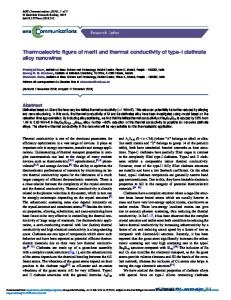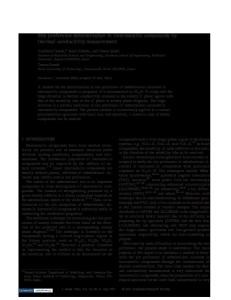Splitting of Guest Atom Sites and Lattice Thermal Conductivity in Ba-Ga-Ge Clathrate Compounds
- PDF / 1,972,451 Bytes
- 6 Pages / 612 x 792 pts (letter) Page_size
- 59 Downloads / 372 Views
0886-F10-04.1
Splitting of Guest Atom Sites and Lattice Thermal Conductivity in Ba-Ga-Ge Clathrate Compounds Norihiko L. Okamoto, Katsushi Tanaka and Haruyuki Inui Department of Materials Science and Engineering, Kyoto University Sakyo-ku, Kyoto 606-8501, Japan ABSTRACT The crystal structures of some type-I and -III clathrate compounds in the Ba-Ga-Ge system have been investigated by synchrotron X-ray powder diffraction at room temperature, paying special attention to the changes of the cage structure and the splitting behavior at the guest atom site upon alloying with Ga. For both types of the clathrate compounds, the split distance of the Ba(2) sites increases with the increase in the Ga content, corresponding to the change in the size and shape of the encapsulating polyhedral cage. Lattice thermal conductivity at room temperature has a positive correlation with the atomic displacement parameter (ADPsplit) based on the split-site model but has an inverse correlation with the split distance of the Ba(2) sites, indicating that a dominant factor of reducing the lattice thermal conductivity is not thermal vibration at the split sites but thermal jump among the split sites. INTRODUCTION Crystal structures of clathrate compounds comprise polyhedral cages and guest atoms encapsulated in the cages. The cages consist of group IV and/or III elements (X) while the guest atoms (M) are typically alkali metals or alkali-earth metals. Clathrate compounds form in a variety of structure types, depending on the combination of different constituting cages [1-5]. Among the various types, the type-I structure with the chemical formula of M8X46 possesses a cubic unit cell with the space group of Pm 3 n and comprises a cage structure consisting of pentagonal dodecahedra and tetrakaidecahedra, encapsulating guest atoms at M(1) 2a sites and M(2) 6d sites, respectively, as shown in figures 1(a) and (b) [1]. On the other hand, the type-III structure with the chemical formula of M24X100 possesses a cubic unit cell with the space group of P4132 and comprises a cage structure consisting of pentagonal dodecahedra and deformed dodecahedra, encapsulating guest atoms at M(1) 8c sites and M(2) 12d sites, respectively, as shown in figures 1(c) and (d) [3,4]. Clathrate compounds generally possess low thermal conductivity, which is considered due to rattling motion (intense vibration) of the guest atoms in the polyhedral cages. The rattling motion is monitored by X-ray and neutron diffraction as an anomalously large atomic displacement parameter (ADP) at the M(2) guest atom sites on the assumption that the guest atom vibrates around the cage center (single-site model) [4,6,7]. When values of ADPs are considerably large, a split-site model is sometimes employed for structure analyses. In the split-site model, the guest atom site is assumed to split into several equivalent sites [8] as shown in figure 2. It is considered that the guest atom thermally jumps among the split sites at high temperatures. Then, an isotropic ADP based on the single-site model
Data Loading...









